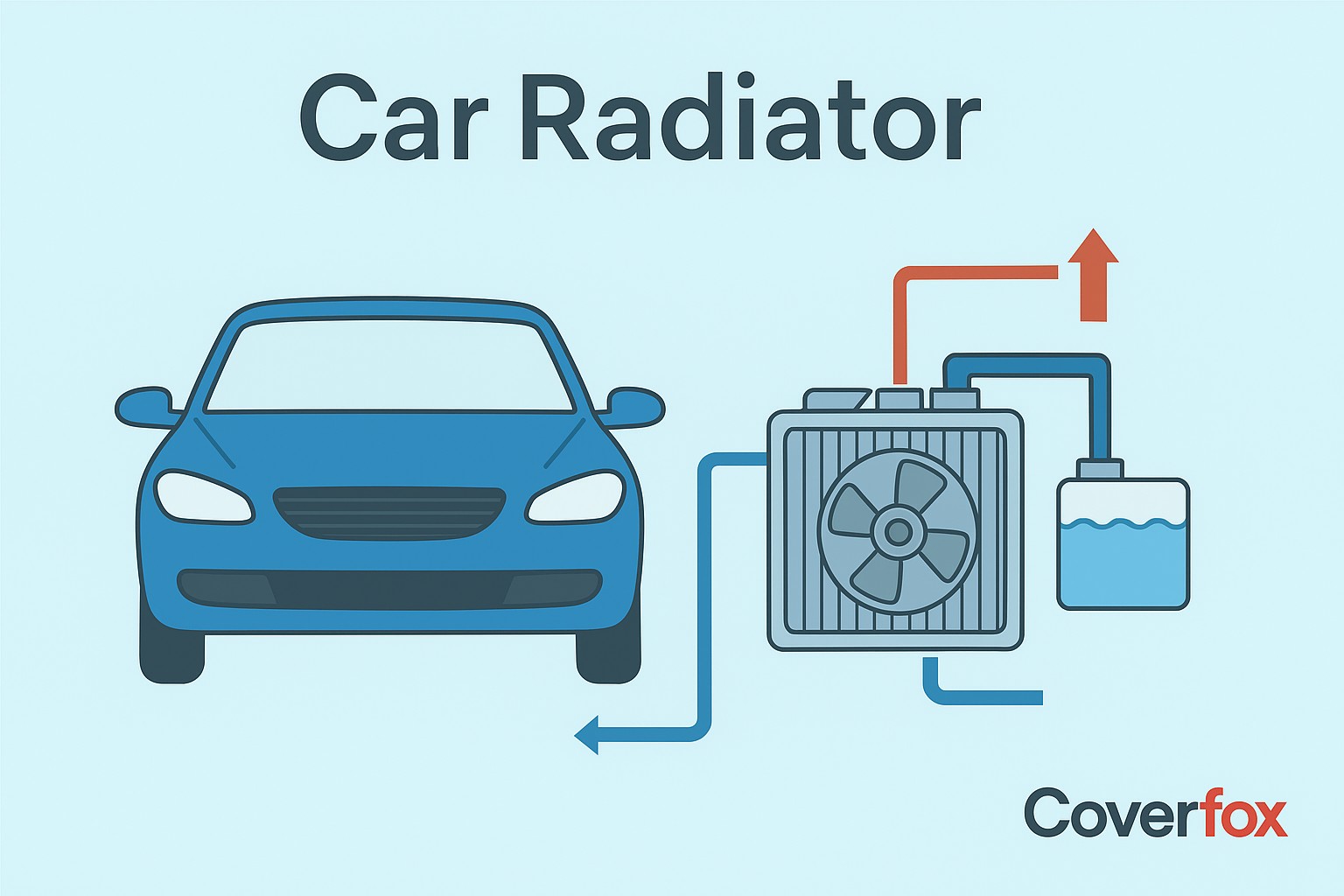A car is a complex machine which requires the working of many essential components to work together for efficient functioning of the car.

As the car starts and moves, it produces a lot of heat, which adds to the already hot and humid climate of India. If not cooled, the car can malfunction and overheat. Here, the radiator comes in. A car radiator helps the car to cool down, but how? To know everything about car radiators, keep reading.
What is a Car Radiator?
A car radiator is an essential component of your vehicle’s cooling system that helps regulate the engine's temperature. It works by circulating coolant through the engine to absorb heat, then dissipating that heat into the air via the radiator’s fins. This prevents the engine from overheating and ensures optimal performance. Without a properly functioning radiator, your car could suffer severe engine damage due to excessive heat.
Key Components of a Car Radiator
Below mentioned are the components of the car radiator.
Core
Inlet and Outlet Tanks
Radiator Cap
Cooling Fins
Thermostat
Radiator Hoses
Fan (Electric or Mechanical)
Overflow Tank
The main part where coolant flows and heat is exchanged.
Direct coolant into and out of the radiator.
Maintains pressure and controls coolant flow to the overflow tank.
Thin metal pieces that help dissipate heat quickly.
Regulates coolant flow based on engine temperature.
Connect the radiator to the engine and circulate coolant.
Pulls air through the radiator to aid cooling.
Stores excess coolant and maintains system pressure.
How Does the Car Radiator Work?
Here’s a step-by-step guide to how a car radiator works:
Engine Generates Heat
Coolant Absorbs Heat
Hot Coolant Flows to Radiator
Heat Dissipation in the Core
Fan and Airflow Assist Cooling
Cooled Coolant Returns
Overflow Tank Manages Pressure
As your car runs, the engine produces a large amount of heat due to combustion.
A liquid coolant circulates through the engine, absorbing this excess heat.
The heated coolant travels through hoses to the radiator.
Inside the radiator’s core, coolant flows through thin tubes surrounded by cooling fins, which release heat into the air.
As the car moves or the radiator fan operates, cool air passes over the fins, speeding up the heat dissipation.
The now-cooled coolant flows back into the engine to repeat the cycle.
Any excess coolant expands into the overflow tank and is drawn back when needed, maintaining a consistent pressure.
Common Problems with the Car Radiator
Here are some common issues that you might face with your car radiator:
Coolant Leaks
Clogged Radiator
Overheating Engine
Corrosion or Rust
Faulty Radiator Cap
Broken Fan or Thermostat
Radiators may face leaks due to cracks or worn-out hoses, leading to coolant loss and reduced cooling efficiency.
If debris, rust, or dirt gets collected, it can clog the radiator, restricting coolant flow and causing the engine to overheat.
When the radiator fails to dissipate heat effectively, the engine temperature rises, especially in traffic or during long drives.
Using old or improper coolant can lead to internal rust or corrosion, damaging the radiator and affecting its performance.
A damaged or loose radiator cap may fail to hold pressure or leak coolant, resulting in improper cooling.
The cooling fan and thermostat help regulate engine temperature; if either fails, it can cause the engine to overheat.
When Should You Replace Your Car Radiator
If you see the following indicators, it is time to replace your car radiator:
- Frequent engine overheating despite coolant levels.
- Coolant leaks under the vehicle or radiator.
- Rust, sludge, or discoloured coolant is visible.
- Damaged or bent radiator fins and tubes.
- Inconsistent or fluctuating engine temperature readings.
Importance of Regular Radiator Maintenance
Like every other part of the car, the radiator also requires regular maintenance for proper functioning. If left unchecked, it can lead to various problems like engine breakdowns, overheated engines, engine malfunctioning, etc. Here are the reasons why regular radiator maintenance is important:
Prevents engine overheating
Improves fuel efficiency
Extends the radiator and engine lifespan
Identifies early signs of damage
Reduces costly repairs
Regular radiator maintenance ensures the engine remains at optimal temperature, preventing overheating and potential engine damage.
A well-maintained radiator helps the engine run cooler and smoother, which in turn enhances fuel economy and overall vehicle performance.
Flushing and cleaning the radiator regularly reduces wear and tear, increasing the longevity of both the radiator and the engine.
Routine checks can catch issues like leaks, rust, or blocked coolant passages early, preventing sudden breakdowns or expensive repairs.
Proactive radiator care avoids major faults in the cooling system, saving you from heavy repair bills and inconvenience.
Summing Up
Radiators work as the cooling system of the car. Without them, your car will overheat and eventually stop working properly. Also, maintaining radiators is equally important, as a faulty radiator can damage your car’s engine, which is not covered by car insurance. So, keep your car cool with radiators, and your mind cooler with car insurance!
Frequently Asked Questions
What is the purpose of a car radiator?
The car radiator acts as the cooling system for the car engine.
Will a car run without a radiator?
A car can run without the radiator for a while, but soon it will overheat and break down.
Does a radiator affect AC?
Yes, issues with the radiator or its fan can have a significant impact on the car's air conditioning system.
Do car radiators need coolant?
Yes, a radiator uses coolant that helps absorb heat from the car engine.
Can I drive my car with a bad radiator?
No, a bad radiator is like an explosion set to boom.
Is the car radiator repairable?
Yes, a car radiator is repairable, depending on the situation, like a clogged radiator can be fixed.
How often should a radiator tank be cleared?
Generally, every two years calls for a coolant change in the radiator.





